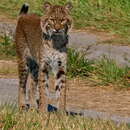More info for the terms:
cover,
density,
forest,
hardwood,
shrub,
shrubs,
tree,
woodlandBobcats are found in a wide variety of plant communities including
coniferous forest, deciduous forest, mixed forest, the Everglades,
prairie and other grasslands, chaparral, sagebrush (Artemisia spp.)
scrubland, creosotebush (Larrea tridentata) scrubland, and mesquite
(Prosopis spp.) scrub [
1].
Bobcats do show some plant community preferences. They commonly occur in
areas with a mosaic of different plant communities and seral stages
[
4,
7,
51]. In Minnesota bobcats preferred areas of black spruce (Picea
mariana), northern white-cedar (Thuja occidentalis), and balsam fir
(Abies balsamea) interspersed with quaking aspen (Populus tremuloides)
and lowland shrubs [
4]. No significant seasonal shifts in habitat use
occurred. Rollings [
35] found that in Minnesota, bobcat winter habitat
was primarily thick northern white-cedar or black spruce swamps. In New
England, bobcats were frequently found in northern white-cedar swamps
and black spruce thickets [
12]. Bobcat habitat in Massachusetts was
characterized by cliff areas, black spruce plantations, and eastern
hemlock (Tsuga canadensis)-hardwood communities [
30].
Common tree and shrub species of bobcat habitat in the Intermountain
West include manzanita (Arctostaphylos spp.), mountain-mahogany
(Cercocarpus spp.), pinyon (Pinus spp.), sagebrush, and juniper
(Juniperus spp.) [
37]. In the Frank-Church River of No Return
Wilderness, Idaho, bobcats selected Douglas-fir (Pseudotsuga
menziesii)/mountain-mahogany (Cercoparus spp.) communities, but avoided
Douglas-fir/wheatgrass communities. The latter communities lacked rocky
terrain and mountain-mahogany cover for bobcats [
49]. Bobcats in
another Idaho study were found in areas dominated by big sagebrush
(Artemisia tridentata) with nearby caves and sagebrush-Utah juniper (J.
osteosperma) areas near volcanic outcroppings. Most of the preference
for these habitats was accounted for by prey density and cover for
hunting and resting [
47]. In Fresno County, California, bobcats were
most common from 2,001 to 4,003 feet (610-1,220 m) elevation, with the
preferred cover types in the eastern portion of the county including
woodland-grass, pine (Pinus spp.)-chaparral, and hardwood woodland [
7].

